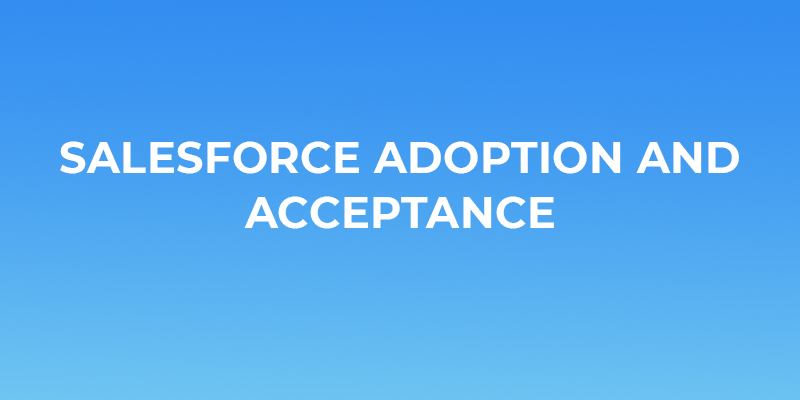
Salesforce Adoption And Acceptance
minutes read
Technology is very significant today because of its revolutionary ways of overthrowing traditional methods. Salesforce being one of the global leaders in CRM and cloud computing solutions deploy extremely meaningful and simplified solutions for companies at all levels of operations. But beyond deployment, actual usage and exercising of these solutions is what matters – in terms of purpose and success.
I still remember being a student, getting accustomed to the technological wave in schooling and educational institutions. When talking about adoption, this is the closest comparison that comes to me, when blackboards were upgraded to plasma TV for a more interactive and virtual educational experience. Then again, traditional teachers took a couple of years to get used to this and, I didn’t get to experience the complete virtual learning experience till the time I graduated.
This is a problem most companies face when they have established cutting edge technologies for modernizing and improving their outcomes, and spending exorbitant amounts on such up-gradation, they barely make it to your interface. Adoption’s biggest challenger can sometimes turn out to be naivety or incomprehension. Here is a series of questions, we can understand what adoption is and how to tackle these challenges.
WHAT IS ADOPTION?
Adoption is nothing but using the available technologies to optimize your operations. Let us take the above-mentioned virtual education transition itself. The educational boards were replaced with projectors and television for more interactive and virtual studying experience. The implementation costs a fortune, along with multiple hours of training for the teachers. Even after this, the teachers are reluctant to engross themselves in such teaching methods, despite advanced facilities. This is because many at times, change come along with resistance. Paul Gibbons, in his book ‘The Science of Successful Organizational Change’, articulates, “People who appear to be resisting change may simply be the victim of bad habits. Habit, like gravity, never takes a day off”. And likewise, you may stay static with the existing environment but it sure won’t drive success with this fast-growing world of business.
WHY THIS RESISTANCE?
As mentioned, change is always followed by some kind of resistance, or reluctance even if they’re aware that such transitional practices are beneficial for oneself or their company. To introspect it further, it could be due to reasons like, not understanding the true value, or the extent of its benefit – they don’t really see what it can do for them. Another reason could be, not knowing how to use or handle such technologies. Then again it need not always be a fault or insufficiency in training. Skepticism must be eradicated from employee/customer minds to unlock the true potential of possessing Salesforce.
WHERE DOES ITS SIGNIFICANCE LIE?
The prime reason to adopt automation is to bridge gaps in any process. And just like how a bridge between two places speeds up the journey, acquiring Salesforce drives growth, which was restricted due to sparse data or input. The way to tackle this is by aligning your goals and priorities, understand clearly what works best for the organization and streamlining those processes. Another crucial aspect is that adoption is proportional to the ROI, where if you don’t put it to use, you are simply wasting away valuable resources. Dissecting its functions, we can learn that Salesforce benefit in a twofold way, where they help the reps with increased productivity, copious data and mobility to work – and for your company, it boosts revenue, real-time visibility into current and future deal, greater transparency and connects and consolidates the activities of various departments, with a holistic overview of the entire operations.
HOW TO ADOPT SUCCESSFULLY
- Let us start with understanding the role or implementation needs of Salesforce in the company. Establish a clear need for it in all departments and make them see the value this new tool will bring to their specific area of business. Emphasis on the investment that has gone into this and makes it clear that the stakeholders expect to use them optimally.
- Even though we analyze the gap before implementing it, once it is installed, make it an inevitable part of your work. Integrate Salesforce with mandatory business processes so people have to use it. Don’t have members waste time with redundant tools and align all necessary practices in your Salesforce platform.
- Provide complete and proper training to your subordinates. Educate your team members on how their daily tasks and roles will be simplified by the oncoming change.
- Involve everyone from the initial stages itself. Do not target people with prejudice that only certain people can comprehend such technology. Take the time to teach everyone and inspire them to adapt to changes, address any training or adoption issues and provide comprehensive training for every single team member.
- Some times the best way to learn is through experience. Along with training, build meaningful reports to show your teammates empirical results and the change such adoption has bought in. Make sure you’ve agreed upon what Salesforce adoption looks like for your organization and measure the extend of adoption.
- When they are accustomed to the first level of adoption, then you can amplify functions by adding more functionality to your process. You can acquire add-ons and plugins from Salesforce AppExchange to completely elevate the Salesforce experience for teams.
- Build a solid training program through synchronized manner such as in-person interactive sessions or virtual means like video OR asynchronous methods like through trailhead or LMS.
- Make each employee an expert in Salesforce by providing best practices for using Salesforce. Along with training, ask your team leads to coach and reinforce usage during team meetings.
- Make your adoption process fun with some games and activities. Keep people engaged and focused by creating some healthy competition and interactive games to really take it to the next level.
